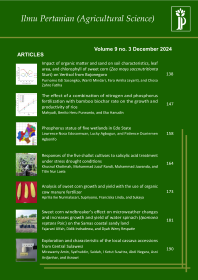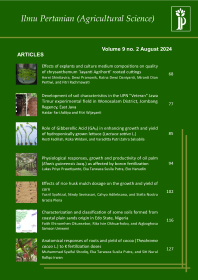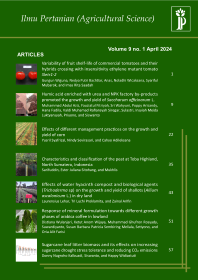How to Mitigate The Production Risks on Coastal Red Chilli Farming in Kulon Progo Regency
Azmi Basyarahil(1*), Irham Irham(2), Lestari Rahayu Waluyati(3)
(1) Magister Management of Agribusiness, Faculty of Agriculture, Universitas Gadjah Mada
(2) Department of Agricultural Socio Economics, Faculty of Agriculture, Universitas Gadjah Mada
(3) Department of Agricultural Socio Economics, Faculty of Agriculture, Universitas Gadjah Mada
(*) Corresponding Author
Abstract
The southern part of the Special Province of Yogyakarta consists of a coastline spanning over 113 km, under the administrations of Bantul, Gunung Kidul and Kulon Progo regencies, that can become an asset and resource of an important economy. Cabe Merah (red chilli) is one of the commodities that show high numbers of productivity in Kulon Progo Regency. Activities of red chilli farming on the coastal land of this regency have been growing, especially since the establishment of commodity auction market to help farmers sell their harvests. The study was conducted to (1) find out the size of production in red chilli agribusiness on coastal land, (2) to analyze the risk levels of production faced by the farmers, and (3) how to mitigate the production risks on coastal red chilli farming. There were 40 participating farmers from Banaran Village, Galur Sub-district, Kulon Progo Regency. The location was intentionally chosen by using multistage area sampling method. The data used were collected from the production and income of three growing seasons. Data analyses were performed using production risk and The House of Risk methods. Based on the variance coefficient, the production risks level was at 0,03 with the production lower limit of 9.596 Kg/Ha, which showed a low level of risk. The various risk mitigation strategies have been performed by the farmers to lessen the risks that can causes losses in the process of coastal red chilli productions.
Keywords
Full Text:
PDFReferences
Anderson, J.R., J.L. Dillon and J.B. Hardaker. 1977. Agricultural Decision Analysis. The Iowa State University Press.
Anonym. 2004. Pengembangan Tanaman Sayuran Lahan Pasir Pantai Model Bimbingan dan Intensisfikasi Massa Terpadu. Dirjen Bina Produksi Hortikultura. Fakultas Pertanian UGM. Yogyakarta.
Arifin. 2013. Risiko Produksi dan Pendapatan Kepemilikan Lahan Daerah Sentra Produksi Padi di Kabupaten Pinrang. Jurnal Vegeta 7 (1) : 1-14.
Curtis, Kynda. 2008. Agribusiness Risk and Risk Management Strategies. University of Nevada, Reno. Virginia.
Elton E.J., M. J. Gruber. 1995. Risk Reduction and Portfolio Size: An Analytical Solution. Journal of Business 50 : 415-37.
Fariyanti, A. 2008. Perilaku Ekonomi Rumah Tangga Petani Sayuran dalam Menghadapi Risiko Produksi dan Harga Produk di Kecamatan Pangalengan Kabupaten Bandung. Disertasi Program Doktor. Sekolah Pascasarjana, Institut Pertanian Bogor.
Heriani, dkk. 2013. Analisis Keuntungan dan Risiko Usahatani Tomat di Kecamatan Sumberejo Kabupaten Tanggamus. Jurnal IIA. 1 (2) : 169-173.
Ihsanudin. 2010. Risiko Usahatani Tembakau di Kabupaten Magelang. Jurnal Embrio. 7 (1) : 21-28.
Imelda. 2012. Analisis Risiko Pada Usaha Penangkapan Kepiting Bakau Di Kecamatan Sungai Kunyit Kabupaten Pontianak. Jurnal Sosial Ekonomi Pertanian. 1 (1) : 75-95.
Kadarsan, H.W. 1995. Keuangan Pertanian dan Pembiayaan Perusahaan Agribisnis. Cetakan Kedua. PT. Gramedia Pustaka Utama. Jakarta.
Kusumaningrum, Juliman Foor Z, dan Dalvi Mustafa. 2015. Social Quality Masyarakat Lahan Pasir pada Aspek Social Empowerment di Kecamatan Panjatan Kabupaten Kulon Progo. Jurnal Agriekonomika, 4 (1) : 1-9.
Mubyarto. 1989. Pengantar Ekonomi Pertanian. LP3ES. Jakarta.
National Statistics Agency. 2015. Data Produksi Cabai Besar, Cabai Rawit, Dan Bawang Merah Tahun 2014. BPS DIY.
Lamusa A. 2010. Risiko Usahatani Padi Sawah Rumah Tangga Di Daerah Impenso Provinsi Sulawesi Tengah. Jurnal Agroland. 17(3):226-232.
Scheaffer, L. Richard, William Mendenhall, Lyman Ott. 1990. Elementary Survey Sampling. PWS – Kent Publishing Company. Massachusetts. Boston.
SCRLC. 2011. Supply Chain Risk Management: A Compilation of Best Practices. Supply Chain Leadership Council.
The MITRE Institute. 2007. MITRE Systems Engineering (SE) Competency Model Version 1, pp. 11, 41-42. Virginia.Article Metrics
Refbacks
- There are currently no refbacks.
Ilmu Pertanian (Agricultural Science) ISSN 0126-4214 (print), ISSN 2527-7162 (online) is published by Faculty of Agriculture Universitas Gadjah Mada collaboration with Perhimpunan Sarjana Pertanian Indonesia (PISPI) and licensed under a Creative Commons Attribution-ShareAlike 4.0 International License.













